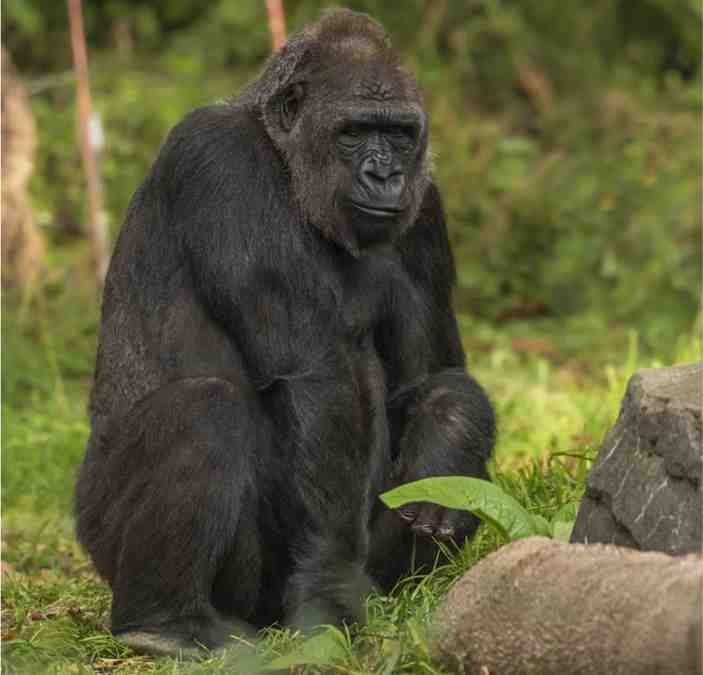What is the scientific name for gorilla? Gorillas are now classified into two main species: the eastern gorilla scientific nameGorilla beringei, and the western gorilla scientific name Gorilla gorilla.
The scientific name of the gorilla may seem simple, but its biological significance and zoological meaning are profound. The gorilla is not only an interesting animal. Gorillas’ major fields of study, such as zoology, evolutionary biology, and conservation science, break their hearts at the thought of the giant. In this guide, we will discuss the scientific name of the gorilla, pronunciation, complete classification, biological meaning, and much more.
Table of Contents
What Is the Scientific Name of Gorilla?
The scientific name of the gorilla is:
- Gorilla gorilla
It is the accepted binomial nomenclature (biological naming system) applied in the Western Gorilla, also known as one of the most well-known species of this primate.
A name follows the Linnaean taxonomy system, where the first part of the name (gorilla) is the name used to classify a given organism under a group called a genus, and the second part (gorilla) is the name of the species. However, such repetition is rare but not unique because the relative identity of the western gorilla is emphasized.
Pronunciation of Gorilla Scientific Name
Gorilla’s biological name is pronounced:
- Genus: guh-RIL-uh
- Species: guh-RIL-uh
The gorilla genus and species are pronounced the same as the common name, but their usage in scientific writing or academic study helps distinguish the species formally.
What Does ‘Gorilla gorilla’ Mean?
Gorilla gorilla, the scientific name for the gorilla, is derived from the Greek language. The name “Gorilla” originates from the Greek word Γόριλλαι (Gorillai), meaning “a tribe of hairy women,” as described by the Carthaginian explorer Hanno circa 500 BC. When European scientists encountered gorillas for the first time, they brought the term back into use for taxonomy.
The inference of the name in modern biology does not carry any negative connotations; it simply describes the genus and species according to the mandate and stipulations of zoological nomenclature.

Gorilla Biological Classification (Taxonomy)
The scientific classification of the gorilla shows how it falls under other organisms in the animal kingdom. Here is a further detailed taxonomy chart:
| Taxonomic Rank | Classification |
|---|---|
| Kingdom | Animalia |
| Phylum | Chordata |
| Class | Mammalia |
| Order | Primates |
| Family | Hominidae |
| Subfamily | Homininae |
| Genus | Gorilla |
| Species | Gorilla gorilla (Western Gorilla) |
According to this classification, gorillas are included in the family Hominidae, the family of humans, chimpanzees, and orangutans. They are a good candidate for evolutionary and medicinal studies due to their similarity in DNA with humans, at 98–99 %.
Subspecies of Gorilla: Scientific and Common Names
There are two main species of gorillas, each with their subspecies:
1. Western Gorilla (Gorilla gorilla)
- Western Lowland Gorilla: Gorilla gorilla gorilla
- Cross River Gorilla: Gorilla gorilla diehli
2. Eastern Gorilla (Gorilla beringei)
- Mountain Gorilla: Gorilla beringei beringei
- Eastern Lowland Gorilla (Grauer’s Gorilla): Gorilla beringei graueri
The above classifications are used by scientists, zoologists, and conservationists to monitor populations and protect habitats.
Natural Habitat and Geographic Range of Gorillas
Gorillas are native to central and western Africa, primarily inhabiting:
- Tropical rainforests
- Montane forests
- Swampy lowlands
- Riverine forests
Western gorillas are generally native to Cameroon, Gabon, the Congo, and Equatorial Guinea, while eastern gorillas are scattered across Rwanda, Uganda, and parts of the Democratic Republic of the Congo.
Importance of gorilla scientific names
A universal name for each gorilla is crucial for conservation practices. According to the IUCN Red List, both species are listed as endangered or even critically endangered and are vulnerable to:
- Habitat destruction
- Poaching
- Disease (e.g., Ebola)
- Human conflict
Scientific names will enable conservationists to focus on subspecies-specific conservation strategies and global agreements.
Gorilla Facts (Physical, Behavioral & Biological)
| Feature | Detail |
|---|---|
| Common Name | Gorilla |
| Scientific Name | Gorilla gorilla (Western Gorilla) |
| Other Species | Gorilla beringei (Eastern Gorilla) |
| Family | Hominidae |
| Order | Primates |
| Average Height (Male) | 5.5 to 5.9 feet (1.7 to 1.8 meters) when standing upright |
| Average Weight (Male) | 300 to 485 lbs (135 to 220 kg) |
| Average Height (Female) | 4.6 feet (1.4 meters) |
| Average Weight (Female) | 150 to 250 lbs (70 to 115 kg) |
| Arm Span | Up to 8.5 feet (2.6 meters) in adult males |
| Color | Black or dark brown-grey; silverback males develop silver hair on the back |
| Lifespan (Wild) | 35–40 years |
| Lifespan (Captivity) | Up to 50+ years |
| Habitat | Tropical forests, lowlands, swamps, and mountains of Central and West Africa |
| Diet | Herbivorous — mostly leaves, stems, fruit, and bamboo |
| Daily Eating Time | 4 to 6 hours per day |
| Social Structure | Live in groups called troops or bands led by a dominant silverback male |
| Gestation Period | About 8.5 months |
| Offspring | Typically 1 baby every 4–6 years |
| Communication | Grunts, hoots, chest beating, and facial expressions |
| Chest Beating | Used by males to display dominance or warn off rivals |
| Sounds They Make | Growls (anger), hoots (curiosity), roars (danger), humming (contentment) |
| Intelligence Level | Extremely high — known to use tools and learn sign language in captivity |
| DNA Similarity to Humans | 98–99% |
| Conservation Status | Endangered or Critically Endangered depending on subspecies |
| Predators | Few natural predators; main threats are humans and habitat destruction |
| Running Speed | Up to 25 mph (40 km/h) for short bursts |

